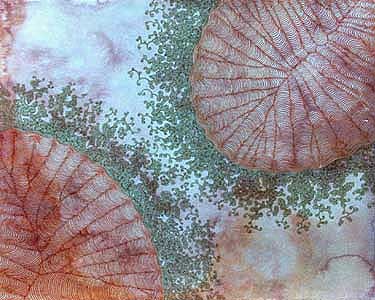
An Artist's Notebook
by Gerald O'Connell
FLUX AETERNA

The Flux Aeterna project commenced in August 1990 with the development of a single imperfect curve. I was, at the time, only faintly aware of the thought processes that had attracted me to the idea, but, as the drawings proceeded, I found much of the activity to be mechanical. I was, therefore, able to reflect at some length upon the genesis of the work, and also upon many aspects of its aesthetic and psychological significance.
I have attempted here to set out some of these reflections and to impose some sort of order and coherence upon them. I should make it clear, however, that I can promise nothing that would amount to a rationale, explanation or justification. Instead, I offer a modest record of some of the thoughts that have formed and accompanied the making of a series of acrylic ink drawings. The series is incomplete, and, I suspect, must necessarily remain so. Much the same can be said for the thoughts...
In July 1990 I afforded myself the luxury of a day spent in various public and commercial art galleries in London. I saw paintings and drawings of every type and from every era. I ended the day, before returning home, by passing a bookshop specialising in exotic travel. In the window was an enormous relief map of part of the Himalayas. Deeply and suddenly fascinated by the flowing density of its contours, I was surprised to find that I drew more pleasure from the map than anything else I had seen that day.
In a popular discussion of cosmological themes I came across the engaging speculation that the entirety of existence is owed to a single random disturbance in the primordial waveform. 'Being', it would seem' is nothing more than the relentless and often chaotic development of this irregularity.
All we have, our only means of understanding, is the picture. The totality of our discourse, internal and external, is by way of analogy - by means of various kinds of pictures. We tend to think of maps as a special, very powerful but limited, type of picture. But perhaps we should regard every picture as really just a type of map - an attempt to make a diagram of an area of thought.
Flux Aeterna could be regarded, perhaps mischievously, as a philosophical enquiry into the nature of change and movement, conducted within cartographic parameters - because some truths cannot be explained, they can only be drawn. The pen is mightier than the word...
There are certain mathematical patterns that are of great fundamental simplicity - basic expressions of quantity and extension. They can seem to act together as a kind of motor for being, always in flux, shifting, ticking away beneath the veil of the physical. They are independent of categories like mass or time. Any graphical representation of them must be totally ambiguous as to scale, appearing at once as both cosmic and microscopic. In such maps there can be no objects or things, only the shadows of action or the trajectories of potential. In an age of religious superstition the cartogropher who sought to record these pathways might have been described as exploring God's fingerprint. In our age of scientific superstition the same activity will, perhaps, be described in terms of chaos theory.
...not things moving, but movement itself - so persistent and inevitable that it creates coagulant clouds and apparitions out of itself; and we mistake these blurred ghosts for the ultimate components, the particles and forces from which, we persuade ourselves, existence itself must be constructed..
I have, from time to time, been forced to describe these drawings as 'abstract'. But the abstract represents forms of conceptual reality, while the representation is merely an abstraction from the real. We cannot stand apart from reality. An idea is a thing. Every attempt to bring reason to bear on this activity seems to end in paradox, and it is not clear whether the problem lies with the activity or with reason itself. Perhaps paradox is all there is...
I am aware that I am making another world for myself, a garden of forking paths where every step taken invites yet more. I walk to feed a sense of astonishment upon which I have come to depend. Thus, what commences as an activity becomes a condition.You can find more paintings from the Flux Aeterna series, as well as other work by Gerald O'Connell at KURAI HOSHI GALLERY
Back to the Astrophysicist's Tango Partner Speaks